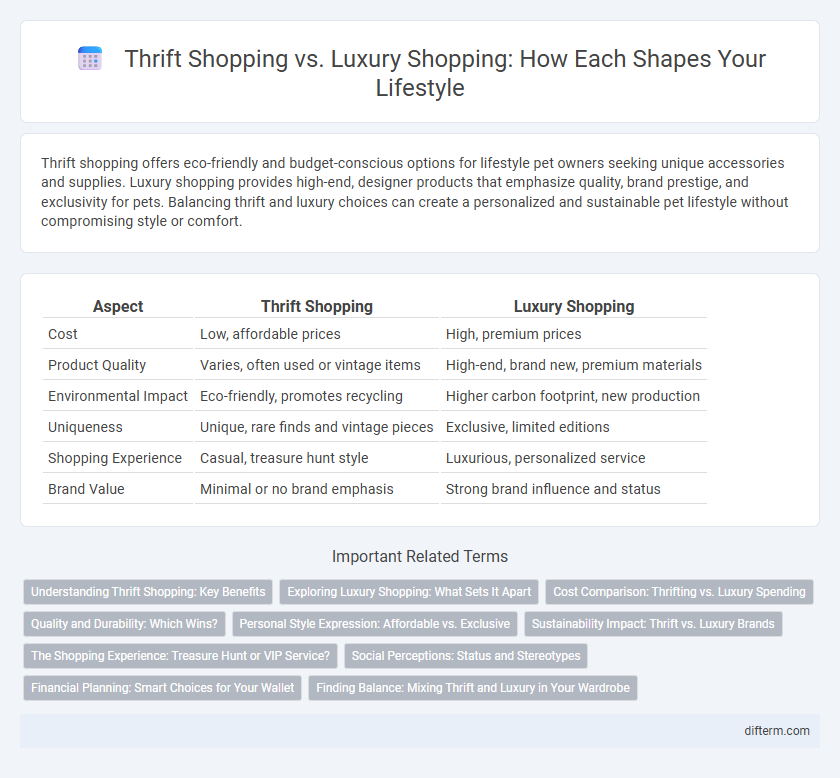Thrift shopping offers eco-friendly and budget-conscious options for lifestyle pet owners seeking unique accessories and supplies. Luxury shopping provides high-end, designer products that emphasize quality, brand prestige, and exclusivity for pets. Balancing thrift and luxury choices can create a personalized and sustainable pet lifestyle without compromising style or comfort.
Table of Comparison
| Aspect | Thrift Shopping | Luxury Shopping |
|---|---|---|
| Cost | Low, affordable prices | High, premium prices |
| Product Quality | Varies, often used or vintage items | High-end, brand new, premium materials |
| Environmental Impact | Eco-friendly, promotes recycling | Higher carbon footprint, new production |
| Uniqueness | Unique, rare finds and vintage pieces | Exclusive, limited editions |
| Shopping Experience | Casual, treasure hunt style | Luxurious, personalized service |
| Brand Value | Minimal or no brand emphasis | Strong brand influence and status |
Understanding Thrift Shopping: Key Benefits
Thrift shopping offers significant financial savings by allowing consumers to purchase quality items at a fraction of luxury prices, promoting budget-friendly lifestyle choices. This sustainable practice reduces waste and environmental impact by extending the life cycle of clothing and goods. Embracing thrift shopping enhances individuality through unique, often vintage finds unavailable in luxury stores, catering to personalized style preferences.
Exploring Luxury Shopping: What Sets It Apart
Luxury shopping distinguishes itself through exclusive brand experiences, high-quality craftsmanship, and personalized customer service that create a sense of prestige and uniqueness. It offers access to limited-edition collections and premium materials that justify higher price points, appealing to discerning consumers seeking status and durability. The immersive retail environment and attention to detail in luxury stores enhance the overall shopping experience, setting it apart from thrift shopping's focus on affordability and sustainability.
Cost Comparison: Thrifting vs. Luxury Spending
Thrift shopping offers significant cost savings, with gently used clothing typically priced at 70-90% less than luxury items, making it an economical choice for fashion enthusiasts. Luxury shopping involves investing in high-end brands that can cost hundreds to thousands of dollars per piece, often reflecting exclusivity, brand prestige, and superior craftsmanship. Consumers balancing budget constraints and style preferences often find thrifting a practical alternative to expensive luxury purchases without compromising on unique fashion finds.
Quality and Durability: Which Wins?
Thrift shopping offers unique, often high-quality items with proven durability, as many secondhand pieces have already withstood the test of time. Luxury shopping provides meticulously crafted products using premium materials and advanced techniques designed for long-lasting use. When comparing quality and durability, thrift finds deliver exceptional value through sustainability and character, while luxury items guarantee superior craftsmanship and longevity backed by brand reputation.
Personal Style Expression: Affordable vs. Exclusive
Thrift shopping offers a unique avenue for personal style expression by providing affordable, one-of-a-kind pieces that reflect individuality without breaking the budget. Luxury shopping, on the other hand, emphasizes exclusivity and high-quality craftsmanship, allowing consumers to showcase status and refined taste through designer labels. Both approaches shape personal style distinctly, balancing financial priorities with the desire for self-expression.
Sustainability Impact: Thrift vs. Luxury Brands
Thrift shopping significantly reduces environmental impact by promoting circular fashion through the reuse and repurposing of garments, lowering textile waste and demand for virgin materials. Luxury brands often entail higher carbon footprints due to resource-intensive production processes and long supply chains, despite some investing in sustainable practices. Choosing thrift over luxury supports sustainable consumption by minimizing pollution, conserving water, and reducing greenhouse gas emissions linked to fast fashion and luxury manufacturing.
The Shopping Experience: Treasure Hunt or VIP Service?
Thrift shopping offers a unique treasure hunt experience, where uncovering rare, vintage, and one-of-a-kind items creates excitement and satisfaction. Luxury shopping delivers VIP service characterized by personalized attention, exclusive product selections, and high-end store environments that prioritize comfort and prestige. The choice between these experiences reflects a lifestyle preference for discovery and sustainability versus exclusivity and convenience.
Social Perceptions: Status and Stereotypes
Thrift shopping is often associated with sustainability, creativity, and budget-consciousness, but it can carry stereotypes of frugality or economic necessity. Luxury shopping is perceived as a symbol of status, wealth, and exclusivity, reinforcing social hierarchies and aspirational lifestyles. Both shopping habits reflect deeper societal values and influence personal identity through the lens of social perception and class distinction.
Financial Planning: Smart Choices for Your Wallet
Thrift shopping offers a cost-effective way to refresh your wardrobe while minimizing expenses, making it an excellent option for budget-conscious consumers focused on long-term savings. Luxury shopping, though often associated with high upfront costs, can be a strategic investment when prioritizing timeless pieces that retain value and reduce frequent replacements. Balancing thrift and luxury purchases within a financial plan supports both smart spending habits and the pursuit of quality, ensuring sustainable financial health.
Finding Balance: Mixing Thrift and Luxury in Your Wardrobe
Integrating thrift shopping with luxury pieces creates a unique wardrobe that balances affordability and high-quality fashion, enhancing personal style without excessive spending. Prioritizing key investment items like designer bags or shoes while sourcing everyday basics from thrift stores maximizes both budget and wardrobe versatility. This blend promotes sustainability by reducing waste and encourages mindful consumption through curated fashion choices.
Thrift Shopping vs Luxury Shopping Infographic

 difterm.com
difterm.com